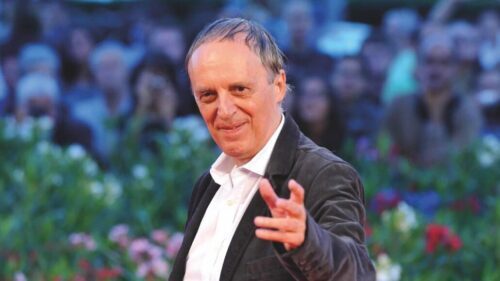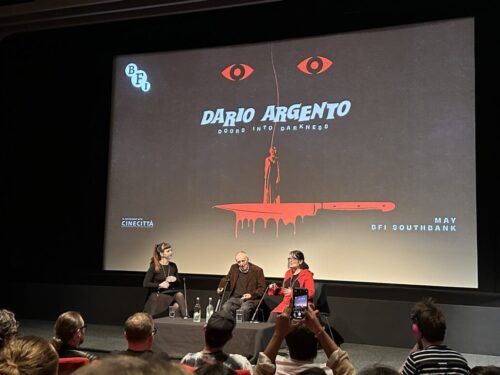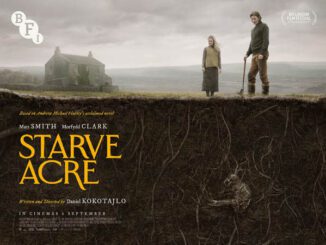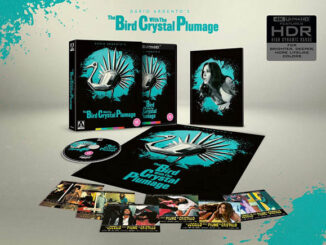
Much like, I imagine, many others who got seriously into horror at an early age, and weren’t just interested in the latest big movies to come out of Hollywood but also wanted to seek out the scariest, bloodiest and weirdest stuff that was about, Dario Argento was one of those filmmakers that I knew quite a bit about before I saw any of his films. It wasn’t a very good time for horror back then. The ludicrous Video Nasty business was supposed to be over, but a lot of good genre stuff which had been pulled by nervous distributors hadn’t been re-released, while our darling censors the BBFC were busy cutting out material they deemed to be unsuitable for home viewing [the best bits then]. Even then I didn’t like the idea of watching censored films, but eventually I did find, in of the three video shops that I frequented, The Cat O Nine Tails which, even though it’s often considered to be [even by Argento himself] one of his weaker efforts, I loved, followed by Inferno which I loved even more. It was a good job that I’d found and rented Inferno, because when I went to hire it out again, it was gone. The owner of the shop told me that, even though it was never on the Director of Public Prosecutions list, he’d found out that it was still a film that he ought not to be stocking. I asked him if I could just buy the video, but he told me that it had already been “sent away”. In any case, I immediately found Argento’s work to be even better than I imagined it to be, I just adored the style, the vibe. How things have changed nowadays. All of Argento’s work can be easily [and legally!] seen uncut and the BFI [the British Film Institute] is holding a major retrospective, showing all of his films in sparkling new restorations, films which used to be generally looked down upon or ignored by critics except for certain luminaries in cultish circles like Alan Jones. And, perhaps best of all, they’d invited the man himself to discuss his work, choosing the perfect person to interview him; Censor writer and director Prano Bailey-Bond. Picking a woman to do it was a nice choice, seeing as Argento has often been accused of misogyny in the past.
Me obviously having a “stupid” day, I thought that there would be twenty minutes of advertisements and trailers – until I realised at the very last minute that this was obviously not going to be the case. The usual mixture of shirts, T-shirts with movie names and artwork on them, and black, lots of black, was still filing into the auditorium when I finally got my arse in gear and rushed into the screen to grab my seat. The event manager came on and told of how he used to go into his older cousin’s bedroom and take out his Argento DVDs to watch which prevented him from sleeping for days. God, such things make me feel old. With me it was videos, yet even the idea of DVDs would seem outdated to some in these very sad days where the concept of actually properly owning the movies you love is on its way out. He introduces Bailey-Bond, then Argento himself, telling us that he’s not long fallen down some stairs but was determined to attend. Indeed, the 83-year old looked rather frail even when he’d discarded his crutch as he sat down, and one could be forgiven for thinking that he wouldn’t be a good interviewee. However, this turned out to certainly not be the case. He answered most of Bailey-Bond’s generally well thought out questions at considerable length, his eyes often suddenly shining and his face losing more than a few years in a second as he seemed to love discussing his work in front of an audience of people who loved the work. He even laughed a few times and adopted a humorous air which seemed different to how I imagined him to be. Mario Bava and Lucio Fulci were the funny ones out of the Holy Trinity of Italian Horror, I always thought until now, with Argento the moody, serious other one.
Now let’s be honest; most of Bailey-Bond’s questions related to things which Argento has gone into in his recent autobiography Fear, but then many people in the audience wouldn’t have read the book; it’s hardly been well publicised, perhaps a telling sign of how Argento’s star has sadly fallen in recent years to the decline in quality of his work, though as stated in my review of the film here, I did find Black Glasses to be his best effort in a while, with bit and pieces of the old magic returning. So if you ignore the book, the questions were just fine and got detailed answers from Argento, aside from the odd occasion where he just didn’t remember stuff or said “no”! in a cheeky fashion. Of course things began with him being asked about his inspirations, then his transition from critic to screenwriter which he found very easy, then onto his debut feature The Bird With The Crystal Plumage. He was responsive to discussing some of the themes in his work such as the importance of art and the act of watching but not participating which can be related to watching, and seems especially prompted when the first museum scene in The Bird With The Crystal Plumage, the opening murder in Suspiria and the gallery sequence in The Stendahl Syndrome were shown on a screen in shortened form. Even though the lights were off while the footage was playing, I could see Argento, who wasn’t even watching it, clearly remembering things. While there’s a strong case for saying that Argento sometimes gives us such a strong opening that the rest of the film can’t quite match it, what I found really interesting, watching these three scenes in fairly quick succession, was how similar they are in all sorts of ways, how the second and third build on what he did before. I don’t think that thought had properly come to me before.

A late clip from Black Glasses suggested that said film would be discussed, but this was not the case, though Argento did answer questions about what’s changed in recent years and working with Gaspar Noe as an actor in Noe’s Vortex. He was sad when saying how cinemagoing is less popular and more people see films at home, but expressed great joy in the latter, which he calls “a beautiful, fantastic experience“. Elsewhere he slightly got it wrong when he says that Opera was cut by 25 minutes – it wasn’t nearly as much as that – but we can forgive him, especially when he sneeringly says that “it was cut to please the Americans” which got a good chuckle, as did certain other responses. It was also obvious what his answer would be to Bailey-Bond’s question about how he feels about bits being removed from his films, but Bailey-Bond generally got it just right. Her praising comments about Argento came across as being totally genuine rather than fake fawning, and she even jokingly tried to start a conversation about favourite deaths, stating that she likes decapitations, though surprisingly Argento ignored this. I’ve always found it a little disappointing that Argento, while he does often mention Bava as an influence, never acknowledges that his first movie was very clearly indebted to Bava’s The Girl Who Knew Too Much; with that and Blood And Black Lace, Bava basically invented the giallo which constantly took bits and pieces from both films.
In the end though, the only major flaw about this occasion was that it was too short – there were things that I really wanted Bailey-Bond to ask Argento – but then he clearly wasn’t at his best physically so it’s possible that the conversation was cut down a bit. When so many luminaries cancel events due to for a variety of reasons, it was most excellent of Argento to still turn up. He also introduced showings of Deep Red, Suspiria and Tenebrae the following day which I was sadly unable to attend I’m in two minds as to whether he should retire. He’s certainly been below par for some time [and this is coming from someone who rather liked his much-derided version of The Phantom Of The Opera], yet his latest opus showed distinct signs of a late regeneration. Come on Dario, give us one more.





I’m sorry to nitpick, but the name of Argento’s latest film is “Dark Glasses”, not “Black Glasses”.
It has actually been released under both of those titles.